Front teeth implantation

Today in the arsenal of dentists there are many ways to return a beautiful smile to people who have lost their teeth.
Implantation of front teeth located in the smile zone is a responsible task from the point of view of aesthetics. Front teeth are the most prominent of all.
The peculiarity of restoration of the front teeth is that they are not intended to be chewed and therefore, the load on them should be minimal and the visual effect should be the best.
When implanting teeth, pins are used that are implanted into the gum bone. The part that protrudes above the gum serves to fix the crown.
When using titanium abutments, the metal can shine through the ceramic-metal crown, the gum can change color, and a gray band may appear at the point of contact of the crown with the gum.
Modern technologies include the manufacture of zirconium abutment. It is a biocompatible material and does not interact with tissues.
From the point of view of aesthetics, the implantation of the front teeth is advisable to carry out in one stage.
In this case, a temporary crown is established at the same time as the implant is implanted. The appearance of the patient with this approach does not visually suffer.
Features of front teeth implants
In the smile zone, special dental implants are used, which have some features:
- The front tooth implant should have a small diameter, which would make it possible to install it reliably and at the same time with minimal damage to surrounding tissues.
- Have a special thread design.
Subject to these requirements for implants, the maximum volume of bone tissue is maintained, soft gum tissue is not injured, and the engraftment process proceeds faster and more efficiently.
All this allows to achieve the highest esthetics of the front teeth.
How is
Front teeth implantation involves several stages.
Preparatory stage

At this stage, planning for a future operation takes place, an anamnesis is collected and a complete examination of the patient is performed.
The patient, both physically and mentally, is preparing for surgery.
- Sanitation of the oral cavity is performed: caries treatment, canal filling, tooth decay removal, periodontitis treatment, professional toothbrushing.
- In the presence of severe forms of periodontal disease or periodontitis, these diseases are treated and the roots of the teeth are strengthened.
- In the presence of atrophic changes in bone tissue at the site of implant placement, bone grafting is performed.
- If prostheses or crowns unsuitable for use are found, they are replaced taking into account the compatibility of materials in order to prevent their corrosion or galvanization.
Surgical stage
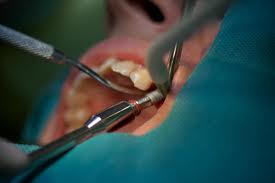
Before the operation, local anesthesia or general anesthesia is performed. Generally acting painkillers are used, their effect continues for another one and a half to two hours after the operation.
At the surgical stage, an anterior tooth implant is implanted in the jaw bone in place of the former root.
The duration of the operation is from thirty to fifty minutes.
Abutment Installation (with the traditional technique)
This procedure is a minimally invasive surgery. At this stage, the mucous membrane of the gums is injured.
Otropedic
This is the final stage of implantation. Prosthetics are performed: installation of a bridge, crown or removable structure.
Of all the above stages, the most important is the quality of the surgical stage.
Since it is precisely its correct conduct that affects how long the implant will last.
Implant Implantation Methods
- Two-stage. At the first stage, the impression is removed from the bone and an implant is made on it. On the second - the bone is prepared for implantation, the implantation process and suturing of the gums.
- One-stage. Jaw computed tomography is performed, based on the data obtained, computer simulation of the implant is performed, and then its manufacture. Then the implant is implanted and the gum is sutured.
What material is made of
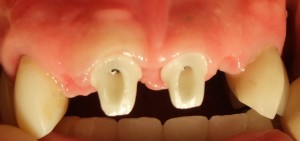
For the manufacture of crowns on front teeth implants, metal-free ceramics is most often used.
Artificial teeth made of zirconium and alumina are indistinguishable from real teeth, perfectly perform their functions and have an unlimited service life.
The advantages of installing prostheses made of aluminum oxide and zirconium during implantation of the front teeth:
- Front teeth implants made from these materials have high strength and lightness, which reduces the load on the gums.
- Biocompatibility, hypoallergenicity of zirconium and alumina.
- When using ceramics, the gums do not lower.
- Tooth tissues and ceramics have the same properties: high thermal conductivity, refraction, color fastness, light transmission.
To achieve an ideal implantation result, it is recommended that all components of the implant be made of non-metal ceramics.
Video: “Immediate implantation in the anterior tooth region”
Advantages of one-stage implantation
- It allows you to quickly and effectively fix defects in the front teeth, freeing the patient from psychological discomfort.
- After implant placement, a temporary crown is placed on the abutment, and the patient leaves the blade on the same day with new teeth.
- A few hours after surgery, the patient is allowed to eat.
Laser application
- To achieve the best effect of implantation of the front teeth, a laser is used. Unlike a scalpel, it significantly reduces the size of the surgical field, reduces the time of the operation to 15-30 minutes, reduces pain.
- The laser beam cuts through the tissue and simultaneously seals the blood vessels, so this method is bloodless. The laser beam also has a disinfecting effect, preventing the development of the inflammatory process.
- After laser application, a photocoagulation film is formed on the wound surface, which protects the wound from the influence of negative factors. All these laser properties allow bone tissue to recover faster, which helps to accelerate implant survival.
- The use of laser implantation of the front teeth does not cause a negative feeling in the patient, it is a more gentle and minimally invasive method. After installing the implants using a laser, the patient has the opportunity to immediately return to a full life.
Complications
Complications during surgery can be a consequence of the mistakes of the dentist, as well as the reaction of the body.
- The feeling of pain during surgery is associated with insufficient analgesia.
- Bleeding in the sinuses.
- Breakdown of bone tissue.
- Overheating of bone tissue at the place of work with drills and boron.
At present, the use of modern equipment in kinniks allows us to reduce the risk of complications to nothing.
Complications after implantation
- Soreness after surgery.
- Swelling.
- The formation of a hematoma.
- An increase in body temperature after surgery.
- The presence of bleeding after implantation.
- Postoperative inflammation. It can be the cause of infection due to insufficient cleaning of the bone bed, with poor oral care after implantation.
- Divergence of seams.
- Implant rejection often occurs as a result of the onset of the inflammatory process. In some cases, rejection may occur in the presence of a burn of the bone as a result of its drilling. The presence of osteoporosis can also affect implant rejection.
- The mobility of an implant. The process of strengthening the teeth in the jawbone continues for 14 to 20 days.
- Increased reaction to sweet and cold.
- Exacerbation of herpes.
Cost
The cost of installing implants on the front teeth consists of many factors. The price includes: the work of medical personnel, the use of equipment, rental of premises, the cost of consumables, payment of water and electricity, taxes of the owner of the clinic.
When installing an implant, a crown is still necessary, the price of which is quite high. The most expensive implants are American and Swiss. Cheaper - South Korean and Israeli, which are no worse than the American, although they are twice cheaper.
The cost of the implant is affected by the shape and material of which it is made. Some configurations, such as root, are initially expensive. If you add to it the cost of the uppermost part, then the cost of implantation will be quite high.
| Service | Cost (c.u.) |
| Single implant placement | from 800 to 1500 |
| Implants manufactured in the CIS | 350 |
| Cermet crown | 400 – 600 |
| Gold frame crown | 800 – 1200 |
| Zirconium frame crown | 650 – 1100 |
You can also choose a more budget version of the crown, then the price will be lower.
In this situation, the cost depends primarily on the material from which the crown is made.
Reviews
Reviews about the installation of implants are often positive. Most often, patients note that even after six or more implants are installed, swelling and pain at the same time completely disappear by the fifth day.
In some cases, complaints of patients installing cermets on their front teeth come down to discoloration of the crowns and translucent pins.
- Six years ago, put two implants on the front teeth. The pins took root for about six months, after which they installed ceramic crowns. The color perfectly matches the rest of the teeth, so it’s completely unnoticeable that the crowns are artificial. The color of the gums also matches the natural.
- I installed one implant in front. Removing and installing a tooth cost me 45 thousand rubles. In two months I will put a permanent crown for 60 thousand. I think so: why save? This is for life. If you do not think about quality, then you can do it cheaper. You can put a crown made of cermet, but then it will be seen that the tooth is not real.
- He made two implants: top front and one tooth on the side of the lower jaw (in the smile zone). By the fourth day, the swelling disappeared, and the pain completely disappeared. Implants took root in six months. Put crowns made of zirconium. Teeth like family. Smile is a pleasure.
Front teeth implantation: before and after photos
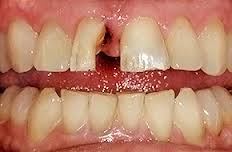 |
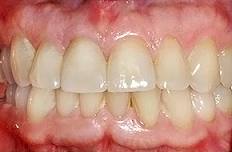 |
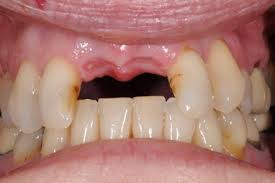 |
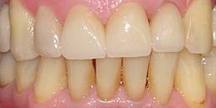 |
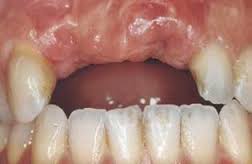 |
 |